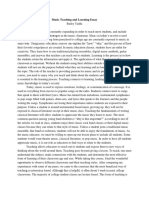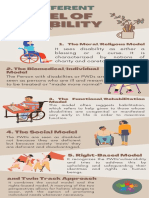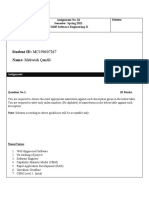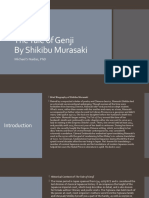100%(1)100% found this document useful (1 vote)
477 viewsFacilitating LCT CHAPTER 5
Facilitating LCT CHAPTER 5
Uploaded by
Mark Kenneth CeballosThis document summarizes several constructivist learning theories including Jerome Bruner's constructivist theory, Gestalt theory, and David Ausubel's subsumption theory. It also discusses cooperative learning and experiential learning. Specifically, it provides an overview of Bruner's view that learning is an active process where learners create new ideas from past experiences. It also outlines the key aspects and principles of Bruner's instructional theory. Gestalt theory and subsumption theory are briefly introduced as well. Cooperative learning techniques and benefits are summarized along with the stages of cooperative learning. Finally, it defines experiential learning and different types of experiences that can aid learning.
Copyright:
© All Rights Reserved
Available Formats
Download as PDF, TXT or read online from Scribd
Facilitating LCT CHAPTER 5
Facilitating LCT CHAPTER 5
Uploaded by
Mark Kenneth Ceballos100%(1)100% found this document useful (1 vote)
477 views16 pagesThis document summarizes several constructivist learning theories including Jerome Bruner's constructivist theory, Gestalt theory, and David Ausubel's subsumption theory. It also discusses cooperative learning and experiential learning. Specifically, it provides an overview of Bruner's view that learning is an active process where learners create new ideas from past experiences. It also outlines the key aspects and principles of Bruner's instructional theory. Gestalt theory and subsumption theory are briefly introduced as well. Cooperative learning techniques and benefits are summarized along with the stages of cooperative learning. Finally, it defines experiential learning and different types of experiences that can aid learning.
Original Description:
Copyright
© © All Rights Reserved
Available Formats
PDF, TXT or read online from Scribd
Share this document
Did you find this document useful?
Is this content inappropriate?
This document summarizes several constructivist learning theories including Jerome Bruner's constructivist theory, Gestalt theory, and David Ausubel's subsumption theory. It also discusses cooperative learning and experiential learning. Specifically, it provides an overview of Bruner's view that learning is an active process where learners create new ideas from past experiences. It also outlines the key aspects and principles of Bruner's instructional theory. Gestalt theory and subsumption theory are briefly introduced as well. Cooperative learning techniques and benefits are summarized along with the stages of cooperative learning. Finally, it defines experiential learning and different types of experiences that can aid learning.
Copyright:
© All Rights Reserved
Available Formats
Download as PDF, TXT or read online from Scribd
Download as pdf or txt
100%(1)100% found this document useful (1 vote)
477 views16 pagesFacilitating LCT CHAPTER 5
Facilitating LCT CHAPTER 5
Uploaded by
Mark Kenneth CeballosThis document summarizes several constructivist learning theories including Jerome Bruner's constructivist theory, Gestalt theory, and David Ausubel's subsumption theory. It also discusses cooperative learning and experiential learning. Specifically, it provides an overview of Bruner's view that learning is an active process where learners create new ideas from past experiences. It also outlines the key aspects and principles of Bruner's instructional theory. Gestalt theory and subsumption theory are briefly introduced as well. Cooperative learning techniques and benefits are summarized along with the stages of cooperative learning. Finally, it defines experiential learning and different types of experiences that can aid learning.
Copyright:
© All Rights Reserved
Available Formats
Download as PDF, TXT or read online from Scribd
Download as pdf or txt
You are on page 1of 16
CHAPTER 5:
CONSTRUCTIVIST
LEARNING THEORIES
Lesson 1: Jerome Bruner’s Constructivist
Theory, Gestalt Theory and David
Ausebel’s Subsumption Theory
Constructivism Defined
Coming from the works of Piaget and Vygotsky, the constructivist
theory of learning posits that learners derive meaning and form
concepts out of their own experiences. In the process, the learner
reflects on the experiences and then creates new understanding
and knowledge from a new experience. If the experience is
related to a previous one, the learner revises the knowledge and
understanding and assessing, the learner constructs and
reorganizes knowledge.
Bruner’s Constructivist Theory
Jerome Bruner believes that learning is an active process where
learners can create new ideas or concepts using their current or
past knowledge about things, events, or situations. Learners can
select information, transform them into new ones, add-up to them
to make decisions or create new sets of understanding. When
properly guided and motivated, learners can even go beyond the
information given to them.
Categorization
Categorization involves perception, conceptualization, learning,
decision-making and making inferences. Bruner encourages
teachers to allow students to discover concepts by themselves
through learning opportunities and activities that allow them to
explore and experiment.
Categorization
Bruner (1996) emphasized four major aspects to be addressed
during the teaching and learning process. These aspects
moderate the process of learning.
❑ Predisposition toward learning
❑ How a body of knowledge can be structured so that it can be
most readily grasped by the learner
❑ The most effective sequences in which to present material
❑ The nature and pacing of rewards and punishments
Bruner’s principle of instruction
1. Instruction must be concerned with the experiences and
contexts that make the student willing and able to learn
(readiness).
2. Instruction must be structured so that it can be easily grasped
by the student (spiral organization).
3. Instruction should be designed to facilitate extrapolation and or
fill in the gaps (going beyond the information given).
Gestalt Theory
Gestalt came from a German term that means pattern or form.
Gestalt psychology was introduced in 1912 by Max Wertheimer. He
is a German psychologist who believed that a whole is more than
just the totality of its parts. The focus of this theory was on grouping.
▪ Similarity
▪ Proximity
▪ Continuity
▪ Closure
Subsumption Theory
The Subsumption Theory was developed by David Ausebel. This
theory emphasizes how individuals learn large amounts of
meaningful material from both verbal and textual presentations in
a school setting. The use of advance organizers is a useful way of
learning. Subsumption means to put or include something within
something larger or more comprehensive
Subsumption Theory
The Subsumption Theory presents four learning processes where a
piece of new knowledge is assimilated into an existing cognitive
structure:
▪ Derivative subsumption
▪ Correlate subsumption
▪ Superordinate subsumption
▪ Combinatorial subsumption
CHAPTER 5:
CONSTRUCTIVIST
LEARNING THEORIES
Lesson 2: Cooperative and Experiential
Learning
Cooperative Learning
Cooperative learning allows many opportunities to develop
learner’s interpersonal skills. It would give them experiences on how
they can properly interact with the others and at the same time
listen and learn from their groupmates.
Cooperative Learning
Cooperative learning has the following features:
1. Students are actively engaged thus, developing in each member, a
cooperative spirit.
2. Each member is challenged to give his or her best because it can create a
healthy and competitive spirit.
3. It allows learners creativity and innovation because they interact with
people their age, peers, or classmates.
4. It develops positivity like open-mindedness, humility and give-and-take
attitude, as well as listening skills.
5. It reduces pressure from work and creates a positive classroom
atmosphere.
Cooperative Learning
Cooperative learning usually follows three stages:
▪ Teachers assign learners to groups.
▪ Tasking is a vital component of cooperative learning.
▪ The working time and task collaboration should be an active
process.
Experiential Learning
Actual hands-on activities are still the most effective means of
learning. Experiences that are direct and purposeful are still the
learners’ best opportunity to master a concept or a skill. Direct and
purposeful experiences are rich experiences that the senses bring,
from which ideas, concepts, generalizations are constructed
(Dale, 1969).
Experiential Learning
Contrived experiences are substitutes for real things, objects or
situations. Examples of these are models, mock-ups, specimens,
simulations, and even games. These are brought or performed in
the classroom because not all things can be brought to the
classroom.
You might also like
- Gap Assessment Reporting FormatDocument150 pagesGap Assessment Reporting FormatRamesh Pandey85% (13)
- Terrorist Explosive Sourcebook Paladin Press BookDocument71 pagesTerrorist Explosive Sourcebook Paladin Press BookJames Meadows90% (20)
- Chapter 4Document121 pagesChapter 420-82506No ratings yet
- LESSON PLAN EppDocument13 pagesLESSON PLAN EppRodel Ortiz Gasmen0% (1)
- Curriculum Essentials Curriculum and The Teacher Curriculum in SchoolsDocument33 pagesCurriculum Essentials Curriculum and The Teacher Curriculum in SchoolsMax ZinNo ratings yet
- Multigrade TeachingDocument3 pagesMultigrade TeachingIlex Avena MasilangNo ratings yet
- Music Teaching and Learning EssayDocument3 pagesMusic Teaching and Learning Essayapi-491571575No ratings yet
- Approaches, Methods, Strategies, TechniquesDocument8 pagesApproaches, Methods, Strategies, TechniquesJan Aries ManiponNo ratings yet
- MAECE 101 Developing Objective Test PPT REPORTDocument20 pagesMAECE 101 Developing Objective Test PPT REPORTDsafadNo ratings yet
- Chapter IiDocument18 pagesChapter IiNathaliaEicellRoseBuenoNo ratings yet
- The Curriculum Should Be Designby Teachers BasedDocument4 pagesThe Curriculum Should Be Designby Teachers BasedRodel YapNo ratings yet
- 609 Reflective JournalDocument5 pages609 Reflective Journalapi-310432086No ratings yet
- Learn To Live TogetherDocument18 pagesLearn To Live TogetherMa Rhodora Saceda-MaNievaNo ratings yet
- Activity 1. Answer The Following. 1. Explain The Two Major Theories On Second Language AcquisitionDocument4 pagesActivity 1. Answer The Following. 1. Explain The Two Major Theories On Second Language Acquisitionvcpm06No ratings yet
- Mother Tongue Module 1Document14 pagesMother Tongue Module 1Sunny RoseNo ratings yet
- Is The Philippines Capable of Multigrade ClassroomDocument4 pagesIs The Philippines Capable of Multigrade Classroomshalimar oronosNo ratings yet
- Chapter 1Document37 pagesChapter 1Gerleen Santiago Lazona100% (2)
- Ed 52 - Multi-Grade Teaching The MentorsDocument5 pagesEd 52 - Multi-Grade Teaching The Mentorsapi-550734106No ratings yet
- Myra O. Anquilo Beed 3A Activity:1 compare your definition with what you have just read about multi-grade. how was your definition similar or different? 》Document3 pagesMyra O. Anquilo Beed 3A Activity:1 compare your definition with what you have just read about multi-grade. how was your definition similar or different? 》Jhay DE ASISNo ratings yet
- Lesson 4Document13 pagesLesson 4Annie Mury SantiagoNo ratings yet
- Social Studies Direct Instruction Lesson PlanDocument3 pagesSocial Studies Direct Instruction Lesson Planapi-270632624No ratings yet
- MC Engl 101 Act 3Document4 pagesMC Engl 101 Act 3Jervyn GuiananNo ratings yet
- EDUC 323 C March 30 2021Document15 pagesEDUC 323 C March 30 2021Je CortezNo ratings yet
- Self-Check, Reflection On Stakeholders in Curr. ImplementationDocument3 pagesSelf-Check, Reflection On Stakeholders in Curr. Implementationannabelle castaneda100% (1)
- The Self From Sociological PerspectiveDocument19 pagesThe Self From Sociological PerspectiveJoseph GratilNo ratings yet
- Group 4 Multigrade Module 8 and Module 9Document41 pagesGroup 4 Multigrade Module 8 and Module 9Yosh HshaNo ratings yet
- LESSON 3 - ExploreDocument3 pagesLESSON 3 - ExploreDora ShaneNo ratings yet
- Green & Brown Neutral Work From Home Productivity List InfographicDocument1 pageGreen & Brown Neutral Work From Home Productivity List InfographicJudith CompasNo ratings yet
- Herbert Spencer Ed 103Document9 pagesHerbert Spencer Ed 103Leslie AnasNo ratings yet
- Michelle Baguinat - ModuleDocument8 pagesMichelle Baguinat - ModuleAnnabeth Chase100% (1)
- Module 4Document18 pagesModule 4Jodelyn Quirao AlmarioNo ratings yet
- An Example of Industrial Arts Is A Welding ClassDocument8 pagesAn Example of Industrial Arts Is A Welding ClassMingNo ratings yet
- Factors To Be Considered in Constructing An Effective ImDocument5 pagesFactors To Be Considered in Constructing An Effective ImJane Limsan PaglinawanNo ratings yet
- Curriculum Influences 1Document12 pagesCurriculum Influences 1Lester YTNo ratings yet
- Document 3Document11 pagesDocument 3Romana Reguyal RamosNo ratings yet
- Lesson 3Document6 pagesLesson 3Jayson Vargas100% (1)
- Students at All Levels. Their Duties Include Assigning Homework, Grading Tests, andDocument2 pagesStudents at All Levels. Their Duties Include Assigning Homework, Grading Tests, andPrecious CabarseNo ratings yet
- Lesson 11 MusicDocument6 pagesLesson 11 MusicKim ArdaisNo ratings yet
- A Detailed Lesson Plan in TLE 4Document8 pagesA Detailed Lesson Plan in TLE 4Irish PolesticoNo ratings yet
- Components Copy From The Sample Your Comments/ SuggestionDocument3 pagesComponents Copy From The Sample Your Comments/ SuggestionSarah MalazagaNo ratings yet
- Ca15 Activity 3 Chapter 2Document1 pageCa15 Activity 3 Chapter 2Mark Kenneth CeballosNo ratings yet
- LESSON 2 - ExploreDocument2 pagesLESSON 2 - ExploreDora ShaneNo ratings yet
- Unit 3 PeDocument16 pagesUnit 3 PeNoralyn Ulnagan ParditoNo ratings yet
- BRUNERDocument28 pagesBRUNERCHizemz Nasayao CuaNo ratings yet
- K To 12 Basic Education Curriculum Description of FrameworkDocument1 pageK To 12 Basic Education Curriculum Description of FrameworkJonel BarrugaNo ratings yet
- Enaje Princess Katrina E. Reflection Module 1 9Document9 pagesEnaje Princess Katrina E. Reflection Module 1 9Richard EstradaNo ratings yet
- Lesson 5Document5 pagesLesson 5Fionna Grace Rojas TonidoNo ratings yet
- Module 3 Educ 9 Bee ExercisesDocument3 pagesModule 3 Educ 9 Bee ExercisesKimverly Gahum De Leon100% (1)
- Rhetorical AnalysisDocument3 pagesRhetorical Analysisapi-588781788No ratings yet
- Ged 203 Teaching Ss in The Primary GradesDocument149 pagesGed 203 Teaching Ss in The Primary GradesSamatha Jane HernandezNo ratings yet
- Pangasinan State University Sta. Maria Campus Sta. Maria, PangasinanDocument5 pagesPangasinan State University Sta. Maria Campus Sta. Maria, PangasinanPrince Aira BellNo ratings yet
- Interview - Napoles, Hazelle O.Document2 pagesInterview - Napoles, Hazelle O.Hazelle NapolesNo ratings yet
- Lesson 4 in Pe AnswersDocument6 pagesLesson 4 in Pe AnswersChristine Joy FernandoNo ratings yet
- Learner-Centered Teaching What Makes It EffectiveDocument11 pagesLearner-Centered Teaching What Makes It EffectiveDiemie AbellanosaNo ratings yet
- Educ3 Mother Tongue Preliminary Module Otilan PDFDocument15 pagesEduc3 Mother Tongue Preliminary Module Otilan PDFjade tagabNo ratings yet
- Teacherhood Activity 1Document4 pagesTeacherhood Activity 1Jhon AgustinNo ratings yet
- Prof Ed 12 JessaDocument3 pagesProf Ed 12 JessaClarizza Mae Abejo100% (1)
- Learning Episode 1 Educational Theories - PONIENTEDocument10 pagesLearning Episode 1 Educational Theories - PONIENTECid Poniente100% (1)
- Educating Learners With Visual Impairment In ZambiaFrom EverandEducating Learners With Visual Impairment In ZambiaRating: 5 out of 5 stars5/5 (1)
- Enhancing Competency of Teachers: A Teaching-And-Learning Enhancement GuideFrom EverandEnhancing Competency of Teachers: A Teaching-And-Learning Enhancement GuideNo ratings yet
- Essentials of Foundations of Education: Introducing New Useful Modern Concepts of Education to Student–Teachers Under B.Ed. TrainingFrom EverandEssentials of Foundations of Education: Introducing New Useful Modern Concepts of Education to Student–Teachers Under B.Ed. TrainingNo ratings yet
- CHAPTER 5: Constructivist Learning TheoriesDocument20 pagesCHAPTER 5: Constructivist Learning TheoriesMia DacuroNo ratings yet
- San Vicente West Urdaneta City, Pangasinan: I.Multiple ChoiceDocument3 pagesSan Vicente West Urdaneta City, Pangasinan: I.Multiple ChoiceMark Kenneth CeballosNo ratings yet
- Science Competency-Based (Nat) Intervention Program of Grade Six Union Elementary School PupilsDocument40 pagesScience Competency-Based (Nat) Intervention Program of Grade Six Union Elementary School PupilsMark Kenneth CeballosNo ratings yet
- Learning Outcomes: Chapter 6: THE GOOD LIFEDocument4 pagesLearning Outcomes: Chapter 6: THE GOOD LIFEMark Kenneth CeballosNo ratings yet
- Pe 2 Mid HandoutDocument5 pagesPe 2 Mid HandoutMark Kenneth CeballosNo ratings yet
- Music, Arts, Physical Education and Health DepartmentDocument4 pagesMusic, Arts, Physical Education and Health DepartmentMark Kenneth CeballosNo ratings yet
- Topic Outline of The Entire Course: Module Writing TemplateDocument33 pagesTopic Outline of The Entire Course: Module Writing TemplateMark Kenneth Ceballos100% (1)
- Orca Share Media1591850928452 6676706716610553397Document5 pagesOrca Share Media1591850928452 6676706716610553397Mark Kenneth CeballosNo ratings yet
- Learning Outcomes:: Chapter 8: Special Issues On TechnologyDocument7 pagesLearning Outcomes:: Chapter 8: Special Issues On TechnologyMark Kenneth CeballosNo ratings yet
- Visual Arts 3-Prelim ModuleDocument11 pagesVisual Arts 3-Prelim ModuleMark Kenneth CeballosNo ratings yet
- University Urdaneta City: Building & Enhancing New Literacies Across CurriculumDocument9 pagesUniversity Urdaneta City: Building & Enhancing New Literacies Across CurriculumMark Kenneth CeballosNo ratings yet
- Mark Kenneth Ceballos - Ethics Activity 2Document3 pagesMark Kenneth Ceballos - Ethics Activity 2Mark Kenneth CeballosNo ratings yet
- Activity #2 Course Code: E337 TitleDocument3 pagesActivity #2 Course Code: E337 TitleMark Kenneth CeballosNo ratings yet
- The Visitation of The Gods: Gilda Cordero FernandoDocument12 pagesThe Visitation of The Gods: Gilda Cordero FernandoMark Kenneth CeballosNo ratings yet
- Activity-1 E337Document3 pagesActivity-1 E337Mark Kenneth CeballosNo ratings yet
- Traditional LiteracyDocument15 pagesTraditional LiteracyMark Kenneth Ceballos100% (1)
- Management of de Quervain Tenosynovitis - A Systematic Review and Network Meta-AnalysisDocument57 pagesManagement of de Quervain Tenosynovitis - A Systematic Review and Network Meta-AnalysisslevinkloseNo ratings yet
- Q 1 ArgumentativegraphicorganizerzoegoldbergDocument8 pagesQ 1 Argumentativegraphicorganizerzoegoldbergapi-329656720No ratings yet
- TB 1 - AklanDocument5 pagesTB 1 - AklanKkaNo ratings yet
- Song For The Mouse (1 and 2 Grade) Song For The Fox (1 and 2 Grade)Document10 pagesSong For The Mouse (1 and 2 Grade) Song For The Fox (1 and 2 Grade)Buse AyvazNo ratings yet
- Basic Electronics Trainer KMS-01Document2 pagesBasic Electronics Trainer KMS-01Saridi SaliminNo ratings yet
- Unit 1 TOEIC (Nouns & Pronouns)Document61 pagesUnit 1 TOEIC (Nouns & Pronouns)Nguyễn Ngọc MaiNo ratings yet
- Training The Sales ForceDocument18 pagesTraining The Sales ForceSwArup Pandya60% (5)
- PCM As 'External Sensor' For: TSC1 With Asset Surveyor SoftwareDocument6 pagesPCM As 'External Sensor' For: TSC1 With Asset Surveyor SoftwarejaviermvNo ratings yet
- Unit 2 - Design Principles and MethodsDocument47 pagesUnit 2 - Design Principles and Methodsmaya_muth100% (1)
- Grammar Extra: Upper Intermediate Unit 8Document2 pagesGrammar Extra: Upper Intermediate Unit 8giorgi chkhatarashviliNo ratings yet
- Aluminium CatalogueDocument34 pagesAluminium CatalogueCitra Dwi KusumawardaniNo ratings yet
- The Consumer Behaviour Towards Online Shopping in TiruchirappalliDocument19 pagesThe Consumer Behaviour Towards Online Shopping in TiruchirappalliSababathiNo ratings yet
- Vedic Astrology Full PDFDocument311 pagesVedic Astrology Full PDFHariNo ratings yet
- The Mycenaean AgeDocument2 pagesThe Mycenaean AgeDr DapperNo ratings yet
- Areva FBX 24kV Tu Trung The RMU 24kV GIS Thanh Cai Cach Dien SF6Document40 pagesAreva FBX 24kV Tu Trung The RMU 24kV GIS Thanh Cai Cach Dien SF6Minh PhuocNo ratings yet
- Astec Advantage ENDocument36 pagesAstec Advantage ENfardalirezaei.alirezaNo ratings yet
- Lulu ProposalDocument20 pagesLulu ProposalTomlee TinoNo ratings yet
- CH 1 and CH 2Document7 pagesCH 1 and CH 2Jessa Mae JavaNo ratings yet
- NCM 103 Final ExamDocument5 pagesNCM 103 Final ExamRichmond LacadenNo ratings yet
- Request For Promugation PHC Memo Final Med Marijuana RegsDocument16 pagesRequest For Promugation PHC Memo Final Med Marijuana RegsloomcNo ratings yet
- Status of Dairy Farming in Nagaland A Descriptive StudyDocument5 pagesStatus of Dairy Farming in Nagaland A Descriptive StudyEditor IJTSRDNo ratings yet
- Prepared By: Engr. Jeffrey P. LandichoDocument9 pagesPrepared By: Engr. Jeffrey P. LandichoPam SantosNo ratings yet
- Manual J1000Document260 pagesManual J1000Jose Luis CaballeroNo ratings yet
- Student ID: MC190407267 Name: Mehwish Qandil: AssignmentDocument2 pagesStudent ID: MC190407267 Name: Mehwish Qandil: AssignmentHasnain aliNo ratings yet
- Testing and Commissioning Procedure For MotorsDocument6 pagesTesting and Commissioning Procedure For MotorsArnold StevenNo ratings yet
- The Tale of Genji by Shikibu Murasaki: Michael S Naidas, PHDDocument21 pagesThe Tale of Genji by Shikibu Murasaki: Michael S Naidas, PHDjohnpenielmontales100% (1)
- 07sep2021 - OEC Song Line-UpDocument5 pages07sep2021 - OEC Song Line-UpDennis GiananNo ratings yet
- GPL 121000Document2 pagesGPL 121000api-170472102No ratings yet








































































































